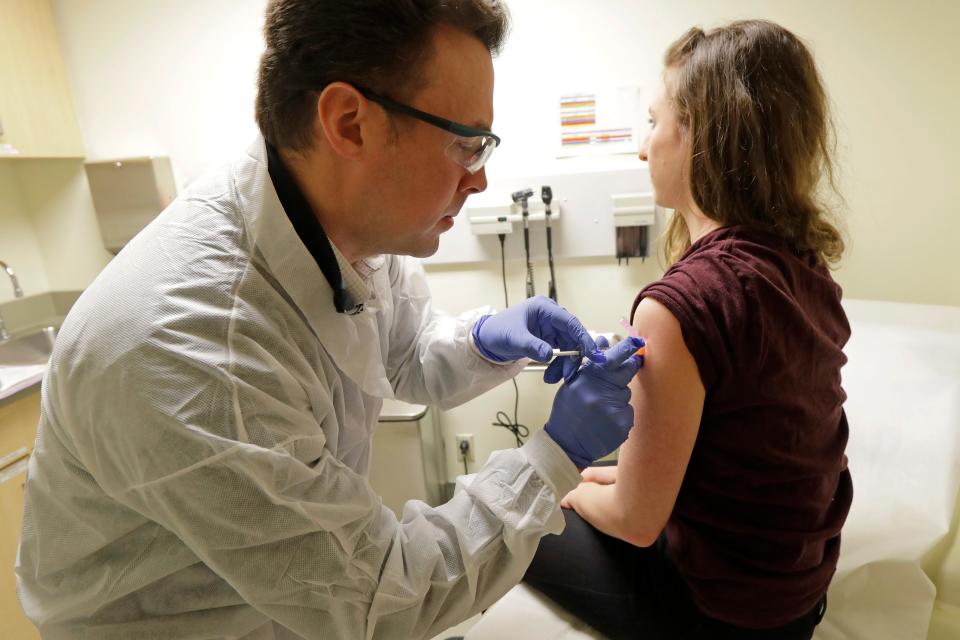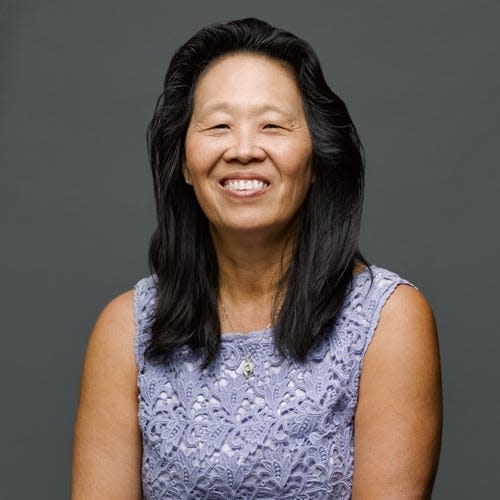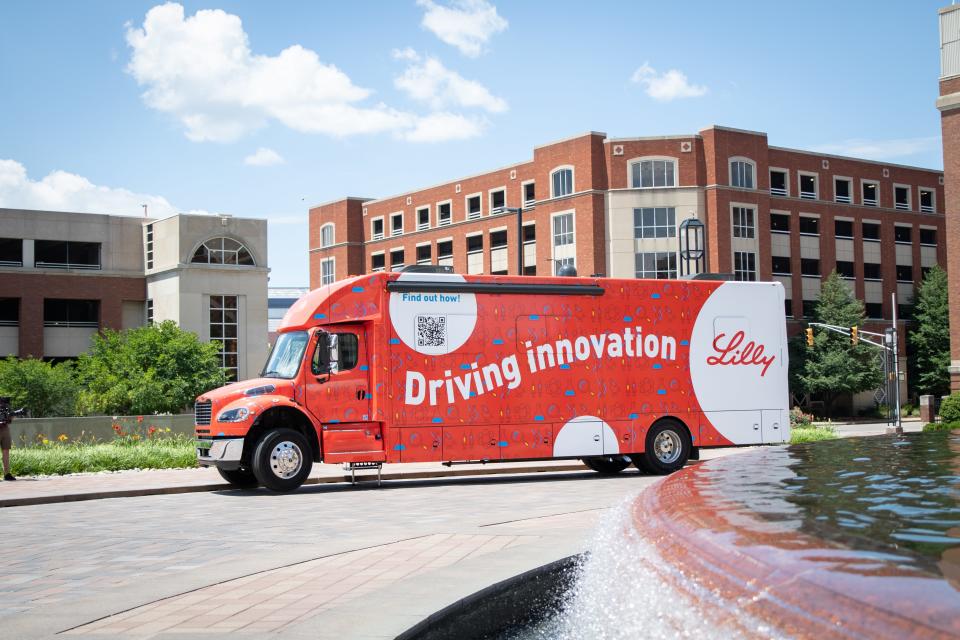One big change is coming to clinical drug trials, and it's 'no longer lip service'
Clinical trials are the lifeblood of drug development. No medicine can win approval without being proven safe and effective in volunteers.
But during the early months of the COVID-19 pandemic, most clinical research was derailed by shuttered clinics and hospitals that didn't have time for anything but urgent care. Suddenly, virtual visits and in-home care – which had seemed impossible before – became routine.
Meanwhile, COVID-19 trials received the kind of seemingly unlimited money and public support that may never be seen again.
The combination taught clinical trial companies several lessons, some of which seem likely to stick long-term. One was the need for diversity.
"If you want people to show up for treatments, you'd better have tested the drugs or vaccines on people who look like them," said Arthur Caplan, a medical ethicist at the New York University Grossman School of Medicine.
Before the pandemic, trial organizers said they aimed for diversity. "We talked a good game about it, but we never really did that much," said Dr. Paul Evans, CEO and president of Velocity, which conducts later-phase trials for drug companies. "It's no longer lip service."
'WE ARE ONLY BEGINNING TO KNOW WHAT IT IS': Why doctors struggle to identify treatments for long COVID
WHAT CAUSES LONG COVID AND ITS STRANGE ARRAY OF SYMPTOMS?Researchers have some clues.
Now, trial organizers are going out of their way to reach patients of diverse backgrounds and in areas that used to be overlooked. They are using video chats instead of all in-person visits to make trials more convenient. And they are reconsidering strict criteria that eliminate those with common medical conditions and often disproportionately affect people of color.
Clinical trials remain the most expensive part of drug development, and the push for diversity drives up the cost even more, Evans said. Reaching beyond the usual sources takes time and effort.
It takes about 12 years to get a drug to market, largely because of the time for clinical trials, said Natalie Schibell, research director at Forrester Research, which analyzes business, marketing and technology trends.
In a typical trial, about 30% of patient volunteers drop out. Recruiting each patient costs about $6,500 and replacing one can run $19,500 – as much as $600,000 to $1 million if it's an early-stage trial with few patients, Schibell said. "All that data, all those resources down the tube."
But the improvement in medical care is worth the extra effort and cost to keep diversifying trials, Evans said. "It certainly means we have a better scientific basis for approving drugs and allowing them to be widely prescribed."

Diversity makes a difference
Trial diversity is essential for understanding diseases and developing effective medications, several experts said.
The blood cancer multiple myeloma, for instance, appears more often among people who are African American – but they are less likely to be included in clinical trials than people who are white, said Dr. David Gerber, a medical oncologist in the Harold C. Simmons Comprehensive Cancer Center at UT Southwestern in Dallas. Scientists won't understand the biological differences until more African Americans can participate in trials, he said.
The same is true in Alzheimer's disease. Inheriting a gene known as APOE4 has been linked to a dramatically increased risk for developing Alzheimer's. But that higher risk has mostly been seen among people who are white, said Rhoda Au, director of global cohort development at the Davos Alzheimer’s Collaborative, which works to accelerate innovation in diagnostics and drug development.
Something different could be going on among participants who are Black and maybe Hispanic, she said. Even less is known about the gene among people who are Asian-American, because a large study has never been done in those trial patients.
OPINION: COVID-19 is still deadly real. Why do we allow disinformation to persist?
To broaden the diversity of its trial participants, the Davos Alzheimer's Collaborative is conducting clinical research in 16 countries in addition to the U.S.
But the push to include trial participants from across the world also requires researchers to rethink some of their traditional approaches, said Au, a dementia and aging expert at the Boston University School of Medicine.
In the U.S., the question considered hardest on a cognitive test asks people to look at a picture of an abacus and name it. But abacuses are commonplace in China. "They're using the same test" in China and the U.S., Au said, but "it's not the testing the same thing."

Despite genuine effort to add diversity, trials still don't truly reflect the broader population of Americans, Caplan said.
Counting 6% of trial participants as "Asian" might reflect their role in the American population but doesn't begin to get at the social, economic or genetic differences between, say, people of Indian, Han Chinese or Korean heritage, he said. "Hispanic" has a similar problem.
Trials also still fail to adequately reflect people with disabilities, trans people and the truly poor, he said. Black people from the Bronx probably also eat different foods, have different backgrounds and be exposed to different pollutants – and therefore might react differently to medications than people from the rural South, wealthy Atlanta or Africa. (Pregnancy is a different consideration, he said, because the fear of harming a fetus.)
Companies and the government have also begun to recognize that restrictions on clinical trials sometimes skew their results.
Requirements affect populations differently, often disadvantaging those already at a disadvantage, Gerber said.
For example, trial thresholds for white blood cell counts are typically set fairly high to ensure patients don't get infections too easily. But Black people typically have a lower white blood cell count than white people, so they are less likely to meet those thresholds, said Gerber of UT Southwestern, where 40% of cancer trial participants belong to underrepresented minority groups.
It's also common for clinical trials to eliminate patients based on the medications they're taking to avoid a drug-drug interaction. But again, Black people are more likely to be taking those medications than people who are white, he said.
Because of strict eligibility criteria, 90% to 95% of people who volunteer for clinical trials in Alzheimer's get screened out, Au said.
"We're telling the vast majority of people who want to participate that they can't participate," she said. "We want to say yes to everyone, but we need to give them a place to go."
Making it easy for volunteers
One of the other big shifts in the past decade and during the pandemic was the public's realization that clinical trials can bring benefit and be personally helpful, Caplan said. Instead of worrying about getting manipulated or abused, he said, patients are now asking, "How come we don't get to do this?"
The history of clinical trials has included many abuses, particularly among people of color. Restrictions and ethics now protect against many of those abuses, though many remain hesitant about participating.
Evans, speaking at an industry panel recently, noted the pandemic provided a moment of public awareness and acceptance of trials – but he's afraid the field is allowing that to slip away. "The general public now understands what we do and how we do it," he said. "We should have taken that bull by the horns and built on it and improved our relationship with the population in general."
HOW DOES COVID-19 AFFECT ME? Don’t miss an update with USA TODAY’s free Coronavirus Watch newsletter
Typically, it's the healthiest, most advantaged patients who participate in clinical trials, the ones who can afford and physically manage to get to the major medical center where trials are usually held. And they are the ones whose doctors know about the trials and encourage their patients to participate.
To encourage more people to participate in trials, the process has to be easy and affordable, experts said.
Volunteers are allowed to be reimbursed for the cost of participation – transportation, parking, lunch money – but won't join if they have to travel too far, said Janelle Sabo, vice president of clinical research capabilities at Eli Lilly, the pharmaceutical giant.
The average American spends at least 80% of their time within 25 miles of their home. "If you can figure out how to deliver a clinical study in that same radius, your likelihood of a patient participating is over 70%," Sabo said. Beyond that, the figure starts to drop. "By the time you're 75 miles or more, you're at single-digit percentages of patients that will say yes."
Because clinical trials have historically been done at major medical centers, anyone who didn't live close to one wasn't likely to participate. And for even those who live close by, "if it costs $10 to get there and they work three jobs, that doesn't fit very well," Sabo said.
In 2020, Bristol Myers Squibb decided that at least 25% of its U.S. trial sites should be close to diverse populations. "We're at 55% right now," said Kate Owen, the company's senior vice president of global clinical development operations.
At those trial sites, where the company has deliberately hired a diverse staff, people of color make up about 40% of participants, she said. "Having the clinics there is making a difference."
Lilly took time during the pandemic to reconsider how it conducts studies, exploring ways to decentralize its trials and avoiding the requirement that participants come into a specific building. "We really looked at what is the best way to deliver that clinical study in the patient's community," Sabo said.

Sabo helped set up mobile research units – converted recreational vehicles that contained everything needed for a trial, including blood draws, labs to analyze that blood and high-tech equipment like that used to scan eyes for disease. Then, the RV could be driven to a nursing home.
"These mobile research units have allowed us to reach a patient population that does reflect the patients we're intending to treat," Sabo said.
Digital technology was transformed from a possibility to practice during the pandemic.
"Pre-pandemic, people were interested and less enthusiastic," Au said. "They become more willing to consider technology as a result of the pandemic."
Older people, who had been thought unable to use computers, adapted. "If a worldwide pandemic prevents them from doing what they want to do," she said, "they'll find a way."
Telemedicine also avoids "white coat syndrome," in which patients get nervous when they have to see a provider in a health care setting, said Forrester's Schibell. People are more relaxed in their own environment, she said. "You get a lot more data and a more realistic perspective on that patient."
The expansion of broadband internet into rural areas, which is expected over the next two to five years, should allow companies to conduct more decentralized clinical trials with more diverse populations, Schibell said.
"When you think about the potential benefits of decentralized clinical trials for gaining real-world evidence, helping companies stand out from the competition, helping to earn trust ... this is really the best way to go for the future of pharmaceuticals."
Contact Weintraub at kweintraub@usatoday.com
Health and patient safety coverage at USA TODAY is made possible in part by a grant from the Masimo Foundation for Ethics, Innovation and Competition in Healthcare. The Masimo Foundation does not provide editorial input.
This article originally appeared on USA TODAY: Clinical trials in line for a major post-COVID change: more diversity

 Yahoo Movies
Yahoo Movies 
